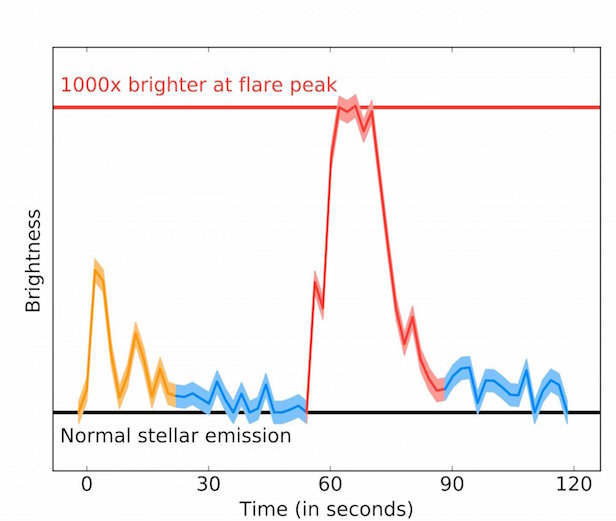Lethal stellar flares bombard Earth’s closest exoplanet
In early 2017, Proxima Centauri exhibited a tremendous stellar flare that could have damaged our closest exoplanet, Proxima b

As Proxima b orbits its host star at roughly the same distance as Mercury does around the Sun, the highly energetic eruption could have had very harmful effects. Image credit: R. M. Candanosa/Carnegie/NASA/SDO/JPL
Life on our closest exoplanet, Proxima b, seems even less likely now, after astronomers detected an enormous stellar flare erupting from its host star Proxima Centauri. Researchers at the Carnegie Institute for Science returned to archive data collected by the Atacama Large Milimeter/submilimeter Array (ALMA), and spotted the occurrence of an extremely energetic explosion of radiation. This could have caused majorly damaging affects to the habitability of the planet.
Carnegie’s Meredith MacGregor, Alycia Weinberger and other collaborators reanalysed archival data collect by ALMA in early 2017, uncovering the monstrous eruption of harmful radiation for a relatively weak star. “March 24, 2017 was no ordinary day for Proxima Cen,” says MacGregor.
Proxima Centauri is an M dwarf star, which is the most common star in our galaxy and has about 10 percent the mass of our Sun. Stellar flares occurring on M dwarf stars are not usually well studied at radio wavelengths, as they are too weak to be detectable by ALMA. However in the case of this study, the peak luminosity of the flare was 10 times brighter than our Sun’s largest flare. This irregular eruption increased Proxima Centauri’s brightness by 1,000 times over a 10 second period. When you include the smaller flare that proceeded, the whole event lasted less than two minutes throughout 10 hours of observations between January and March.
Stars can be subject to capricious behaviour, and stellar flares are result of unpredictable changes in the star’s magnetic field. As electrons are accelerated by the star’s magnetic field, they also interact heavily with charged plasma. This causes an almighty eruption that is observable across the entire electromagnetic spectrum.

Proxima Centauri’s massive stellar flare, shown in red, and the smaller flare beforehand, shown in orange, lasted less than two minutes. Image credit: M. MacGregor
“It’s likely that Proxima b was blasted by high energy radiation during this flare,” explains MacGregor, adding that it was already known that Proxima Centauri experienced regular, although smaller, x-ray flares. “Over the billions of years since Proxima b formed, flares like this one could have evaporated any atmosphere or ocean and sterilised the surface, suggesting that habitability may involve more than just being the right distance from the host star to have liquid water.”
This discovery came about when MacGregor, Weinberger and the rest of the team re-examined a paper presented in November 2017. In this paper, they had calculated the average brightness for Proxima Centauri, using the data that included both the light output of the star and its enormous flare. From this average brightness, they concluded that there was a multiple disk system, relatable to our Solar System’s Kuiper Belt and asteroid belt, surrounding Proxima Centauri. They also went as far as to say that there could be more planets and planetary bodies hidden within this system. In this latest study by MacGregor and collaborators, they dissected ALMA’s data and were able to isolate the unusually erratic flare from the material.
“There is now no reason to think that there is a substantial amount of dust around Proxima Cen,” says Weinberger. “Nor is there any information yet that indicates the star has a rich planetary system like ours.”
Keep up to date with the latest reviews in All About Space – available every month for just £4.99. Alternatively you can subscribe here for a fraction of the price!




